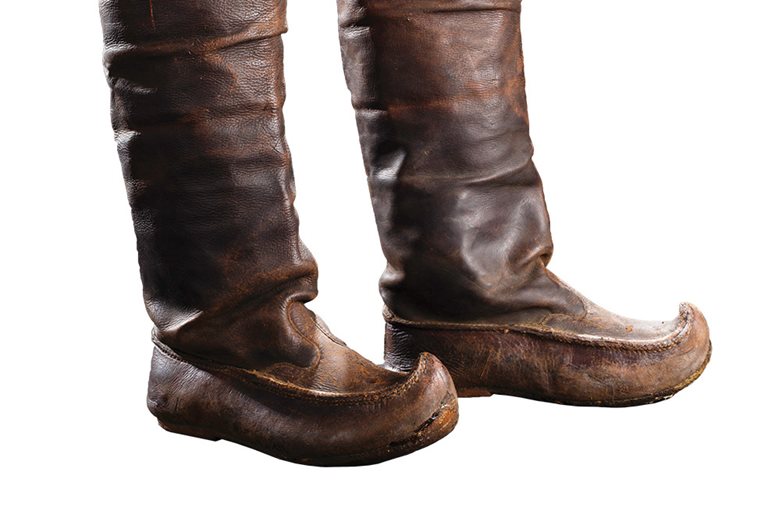The Ins and Outs of the Corset
-
 Advertisements for the corset illustrated the virtues that this undergarment held for some. Print by commercial illustrator John Henry Walker.McCord Museum
Advertisements for the corset illustrated the virtues that this undergarment held for some. Print by commercial illustrator John Henry Walker.McCord Museum -
 The centre corset is made for a child. Mid-eighteenth century-America.The Kyoto Costume Institute, photo by Toru Kagure
The centre corset is made for a child. Mid-eighteenth century-America.The Kyoto Costume Institute, photo by Toru Kagure -
 Nineteenth century engraving by John Henry Walker illustrates a booth set up by the Crompton Corset Company at an exhibition to promote its wares.McCord Museum
Nineteenth century engraving by John Henry Walker illustrates a booth set up by the Crompton Corset Company at an exhibition to promote its wares.McCord Museum -
 Corset made of silk, 1891. Maison Léoty (French, late 19th century).The Metropolitan Museum of Art
Corset made of silk, 1891. Maison Léoty (French, late 19th century).The Metropolitan Museum of Art -
 The Lady's Newspaper and Court Chronicles targeted a female readership. The newspaper was published in London, English and became available in Canada in the late nineteenth century.McCord Museum
The Lady's Newspaper and Court Chronicles targeted a female readership. The newspaper was published in London, English and became available in Canada in the late nineteenth century.McCord Museum -
 Illustration from the Ladies Home Journal, October 1900, contrasting the old Victorian corseted silhouette with the new Edwardian "S-bend" corseted silhouette.Anonymous, Wikipedia commons
Illustration from the Ladies Home Journal, October 1900, contrasting the old Victorian corseted silhouette with the new Edwardian "S-bend" corseted silhouette.Anonymous, Wikipedia commons
The corset first became popular in sixteenth-century Europe. Originating in Italy, the fashionable undergarment made its way to France soon after. These corsets focused more on flattening the bust instead of narrowing the waistline. A farthingale (a stiff hoop skirt) made a woman’s waistline already seem smaller.
By the 1550s corset fashion had made its way to Britain. Advancements in corset construction followed. British corset makers used baleen whale bone and wood sewn into a casing on the corset to maintain a stiff shape.
The corset’s popularity had a bit of a lull in the seventeenth as fashion became simpler. The introduction of the high empire waistline in the eighteenth-century de-emphasized the natural waistline keeping corsets at the wayside.
With 7 uniquely curated newsletters to choose from, we have something for everyone.
After the corset hiatus it peaked in popularity the Victorian era (1837 to 1901). During the reign of Queen Victoria, steel began to replace whalebone and clasps were included on the front along with eyelets on the back. The corset design was changing. The convenience of dressing oneself and cost were factors introduced by the many classes of women who were wearing the corset.
Accentuating the bust and the waist were no longer satisfactory reasons to wear a corset. Supporting the back and improving posture were two new reasons for Victorian women to wear a corset. The health benefits of wearing a corset soon become a marketing tool.
The appeal of the corset had finally made its way to Canada. Canadian women wore corsets for a number of reasons, but the underlying truth was to slim the figure. It wasn’t too long before the corset was redesigned. The S-curve corset came into fashion in the Edwardian era (1901 to 1914) and it narrowed a women’s waistline by flattening the abdomen, which arched her back and threw her bust forward. This style, along with full-sleeves and a bell-shaped skirt allowed women to achieve the newer S-bend silhouette.
Upper class women imported their handmade corsets from France or England, but by 1880s all women could purchase a machine-made corset from companies that had started up in Canada.
The Crompton Corset Company was incorporated in 1880 in Toronto. It employed over 350 workers, who were mostly women, and produced approximately 8,400 corsets a week. In 1886, Dominion Corset was founded in Quebec City and by 1911 it produced almost 5,500 corsets a day.
The Crompton and Dominion battled for the title of largest corset manufacturer in Canada until 1901 when Eaton’s also began selling corsets.
Corsets remained a staple part of Canadian women’s fashion until the outbreak of the First World War. While upper class women could maintain the fashion, many women traded in the corset for a girdle. Using elastic fabrics, the girdle was less restricting and more comfortable while providing the appearance of a flat stomach for women.
We hope you’ll help us continue to share fascinating stories about Canada’s past by making a donation to Canada’s History Society today.
We highlight our nation’s diverse past by telling stories that illuminate the people, places, and events that unite us as Canadians, and by making those stories accessible to everyone through our free online content.
We are a registered charity that depends on contributions from readers like you to share inspiring and informative stories with students and citizens of all ages — award-winning stories written by Canada’s top historians, authors, journalists, and history enthusiasts.
Any amount helps, or better yet, start a monthly donation today. Your support makes all the difference. Thank you!
Themes associated with this article
Advertisement
You might also like...

Canada’s History Archive, featuring The Beaver, is now available for your browsing and searching pleasure!








